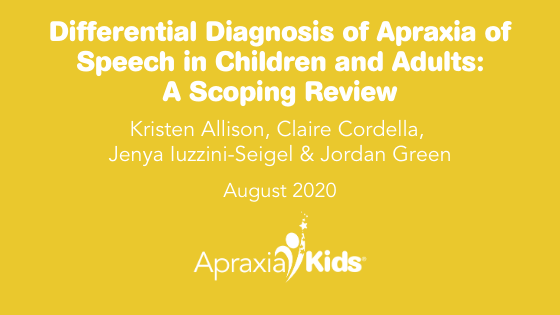
16 Sep Differential Diagnosis of Apraxia of Speech in Children and Adults – A Scoping Review
Kristen Allison, Claire Cordella, Jenya Iuzzini-Seigel, and Jordan Green
Summary by Kristen Allison
Diagnosing childhood apraxia of speech (CAS) is challenging for speech-language pathologists because there is no clear set of validated criteria for diagnosis. In recent years, there has been a tremendous amount of research focused on identifying unique speech characteristics that indicate an impairment in speech motor planning/programming and can be used to improve diagnosis of CAS. Acquired apraxia of speech (AOS) is also a disorder of speech motor planning and programming, but affects adults, often following a stroke. Like CAS, AOS is also lacking a clear consensus on characteristics for diagnosis.
In this review paper, we examined published research studies from the past two decades to see what approaches to diagnosis of CAS and AOS have the most evidence supporting their use, and to examine similarities and differences between what’s known about diagnosis of CAS and AOS. We found four main approaches that have been used to study diagnosis of both CAS and AOS: 1) describing and measuring speech symptoms, 2) measuring aspects of the speech signal or facial movements, 3) experiments using tasks designed to target speech motor planning, and 4) brain imaging. Overall, studies have led to improved understanding of apraxia in both children and adults and identified several measures that may help with diagnosis; however, more research is needed before clear guidelines for clinicians can be developed.
For clinicians and parents of children with CAS, there are a few important takeaways from this review. First, there is increasing consensus emerging around a core set of speech characteristics for clinical diagnosis of CAS (i.e., the Mayo 10 criteria, Shriberg et al., 2011). Second, studies showed the importance of including speech tasks of varying complexity as part of evaluations in order to identify symptoms. Finally, a few quantitative measures of the speech signal are promising potential markers of CAS, but few have enough evidence to support their use in clinical practice at this point and more work is needed to translate them into tools that can be implemented in clinical settings.
Allison, K., Cordella, C., Iuzzini-Seigel, J., and Green, J. (2020) Differential diagnosis of apraxia of speech in children and adults: A scoping review. Journal of Speech, Language, and Hearing Research. 63(8), 1-46.
https://doi.org/10.1044/2020_JSLHR-20-00061
Click here to download a PDF version of this article.
Kristen Allison, Claire Cordella, Jenya Iuzzini-Seigel, and Jordan Green
Summary by Kristen Allison
Diagnosing childhood apraxia of speech (CAS) is challenging for speech-language pathologists because there is no clear set of validated criteria for diagnosis. In recent years, there has been a tremendous amount of research focused on identifying unique speech characteristics that indicate an impairment in speech motor planning/programming and can be used to improve diagnosis of CAS. Acquired apraxia of speech (AOS) is also a disorder of speech motor planning and programming, but affects adults, often following a stroke. Like CAS, AOS is also lacking a clear consensus on characteristics for diagnosis.
In this review paper, we examined published research studies from the past two decades to see what approaches to diagnosis of CAS and AOS have the most evidence supporting their use, and to examine similarities and differences between what’s known about diagnosis of CAS and AOS. We found four main approaches that have been used to study diagnosis of both CAS and AOS: 1) describing and measuring speech symptoms, 2) measuring aspects of the speech signal or facial movements, 3) experiments using tasks designed to target speech motor planning, and 4) brain imaging. Overall, studies have led to improved understanding of apraxia in both children and adults and identified several measures that may help with diagnosis; however, more research is needed before clear guidelines for clinicians can be developed.
For clinicians and parents of children with CAS, there are a few important takeaways from this review. First, there is increasing consensus emerging around a core set of speech characteristics for clinical diagnosis of CAS (i.e., the Mayo 10 criteria, Shriberg et al., 2011). Second, studies showed the importance of including speech tasks of varying complexity as part of evaluations in order to identify symptoms. Finally, a few quantitative measures of the speech signal are promising potential markers of CAS, but few have enough evidence to support their use in clinical practice at this point and more work is needed to translate them into tools that can be implemented in clinical settings.
Allison, K., Cordella, C., Iuzzini-Seigel, J., and Green, J. (2020) Differential diagnosis of apraxia of speech in children and adults: A scoping review. Journal of Speech, Language, and Hearing Research. 63(8), 1-46.
https://doi.org/10.1044/2020_JSLHR-20-00061
Click here to download a PDF version of this article.
Credentials:
Hours of Operation:
Treatment locations:
Address:
,
Phone:
Email:
Overall Treatment Approach:
Percent of CAS cases:
Parent Involvement:
Community Involvement:
Professional consultation/collaboration:
Min Age Treated:
Max Age Treated:
Insurance Accepted:




